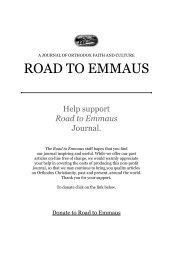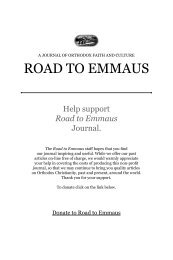RTE No 20 Interior - Road to Emmaus Journal
RTE No 20 Interior - Road to Emmaus Journal
RTE No 20 Interior - Road to Emmaus Journal
Create successful ePaper yourself
Turn your PDF publications into a flip-book with our unique Google optimized e-Paper software.
<strong>Road</strong> <strong>to</strong> <strong>Emmaus</strong> Vol. XII, <strong>No</strong>. 2 (#45)CROAGH PATRICKtile, but you stick <strong>to</strong> your own, and your own certainly weren’t Travellers.<strong>RTE</strong>: Can you tell Travellers by their dress?MICHAEL: Sometimes, and the girls often have big earrings, but you canmore often tell by their names and their accents. It’s a closed community andthey don’t marry out, so they have a very particular way of speaking English.Though everyone has their own regional speech, the dialect that many of theTravellers speak is literally medieval English and medieval Irish—it’s one ofthe secret languages of Ireland, if you like. In some areas, notably Tuam andGalway, there are still a lot of Traveller words in colloquial English.You can also tell Travellers by the nomadic routes that they follow aroundthe country. They travel back and forth <strong>to</strong> Scotland also, though there havebeen Scottish laws from the 13th century prohibiting them from disrupting<strong>to</strong>wnspeople. When the British came <strong>to</strong> Ireland, they almost went crackedbecause, although they were used <strong>to</strong> the regular Irish, they weren’t at all used<strong>to</strong> these nomads who just didn’t pay any heed <strong>to</strong> central government and hadno sense of private property.Whereas climbing the Reek is a regular thing for most of the settled population,there’s this especially strong attachment <strong>to</strong> it for the Travellers. Thelast woman killed on Croagh Patrick was a Traveller woman. She vowed <strong>to</strong>climb it three times, one after another on the same day in the middle of winterbecause her nephew was sick. On the second climb she slipped and fellabout 1500 feet. The pilgrimage tradition has this older edge <strong>to</strong> it as well.What you may be looking at with these people is a survival of early his<strong>to</strong>ricmetalsmiths, who may have created some of the finest works of art in earlyChristian Ireland. As I said, this was their original function in early Christiansociety, taking their trades <strong>to</strong> the various lordships and monasteries. Whenthat medieval culture was broken up, they began their long his<strong>to</strong>ric slide in<strong>to</strong>social dislocation. Nevertheless, they are a wonderful part of all pilgrimages,and they have a great devotion <strong>to</strong> Our Lady, Patrick, Brigid, and a whole hos<strong>to</strong>f other saints.Night Pilgrimage on the Reek<strong>RTE</strong>: Why was Croagh Patrick’s night pilgrimage s<strong>to</strong>pped?MICHAEL: We don’t know why precisely. There are many rumors, but theMarian shrine at Knock may have had something <strong>to</strong> do with it. 1 Knock washeavily promoted and reliably Catholic, unassociated with the dodgy s<strong>to</strong>riesof Patrick fighting the demon Crom Dubh, and all of the pre-Christian possibilitiesthere. Some think that some of the bishops may have wanted <strong>to</strong> giveCatholic Ireland a pure shrine <strong>to</strong> go on pilgrimage <strong>to</strong>, and <strong>to</strong> let these olderones sort of slide off. That first pilgrimage I went on in 1974 was the last nightpilgrimage, and it coincided with the revival of Irish music and festivals, includinga lot more celebrating. The clergy felt that it was getting <strong>to</strong>o raucous,<strong>to</strong>o out-of-order, and quite a few people would be drunk starting up.<strong>RTE</strong>: Was that dangerous?MICHAEL: Well, you know they say that if you slip drunk you don’t get hurt.Those who were stiff and tried <strong>to</strong> save themselves were more liable <strong>to</strong> gethurt. When you think of the number of people going up and how steep it is atthe end, it’s remarkable how few do die. Probably every other year someonedies, but generally from a heart attack rather than actually falling. The reasongiven for it being s<strong>to</strong>pped was that people were getting hurt, but the truth is,it isn’t any safer in the light. Before, when it was dark you wouldn’t go outsidethe boundary of the light, because you knew there was a drop, but in daylightpeople get off the main path. A man died doing that just two years ago.Certainly the people of Morrisk, the village at the bot<strong>to</strong>m of the mountain,weren’t happy when the night pilgrimage s<strong>to</strong>pped, but hundreds of people,thousands probably, still climb it at night, including the Travellers. <strong>No</strong> onewill s<strong>to</strong>p you, but mass doesn’t start now until eight o’clock in the morning.<strong>RTE</strong>: Are there other set prayers that people say going up at traditional restingplaces or wayside shrines?MICHAEL: Yes, there are a series of stations on the ascent where pilgrimstraditionally s<strong>to</strong>p. At each station a series of traditional prayers would berecited—Our Fathers, Hail Marys, and the Creed—often while the pilgrimcircled the station on their knees, although this is now dying out.1 Ed. note. The Marian Shrine at Knock: On August 21, 1879, fifteen people, age five <strong>to</strong> seventy-five, reportedseeing an apparition of the Mother of God, St. Joseph, and St. John the Evangelist in the south gable of theKnock parish church. The apparitions appeared during daylight, as bright, unmoving figures and stayed untilwell after dusk. Although the praying witnesses were wet from the rain, they reported that the ground underthe apparition remained dry. The apparitions were repeated three times in the following spring. Variouspossible natural theories explaining the apparition were investigated by church authorities, but none wereproved. A basilica was built at Knock in the <strong>20</strong>th century <strong>to</strong> memorialize the event, and the Roman Catholicpilgrimage site was given official approval by Pope John Paul II in 1979, on the centenary of the apparition.1415










